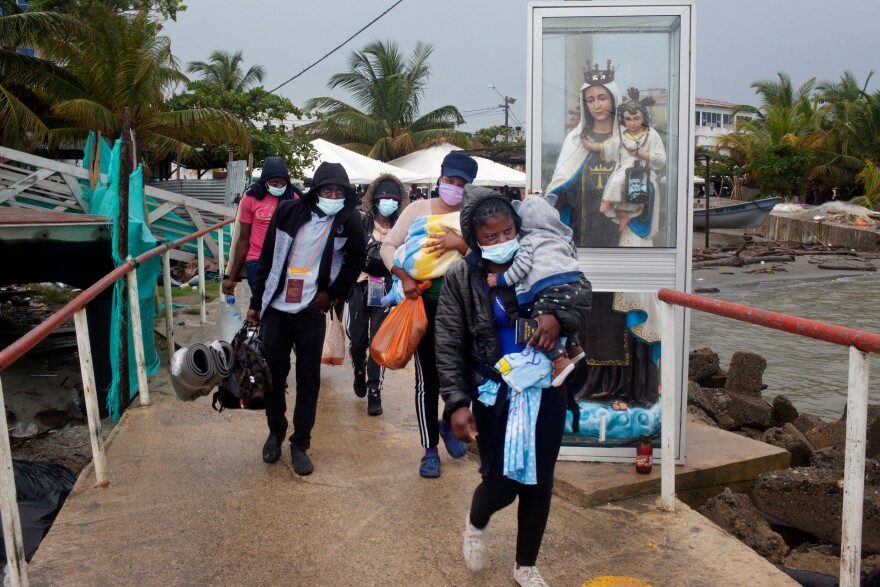Updated September 29, 2021 at 9:06 AM ET
NECOCLÍ, Colombia — This town's Caribbean beaches used to fill up with tourists but there's no longer room. Instead, thousands of Haitian migrants who can't afford the hotels have pitched tents on just about every patch of sand.
Nearly 20,000 Haitians, who are on their way to the United States, are now holed up in Necoclí, forming a human bottleneck even bigger than the recent migrant logjams on the U.S.-Mexican border.

Bruno Noel got to Necoclí two weeks ago with his wife and 6-month-old son and notes his many compatriots speaking Haitian Creole on the boardwalk. "This is like a smaller version of Haiti," he quips.
Lacking visas, Noel and other Haitians are taking a roundabout, overland route to get to the U.S. Many moved to Brazil, Chile and other South American nations following Haiti's devastating 2010 earthquake. But now that countries in the region have eased pandemic travel restrictions, throngs of Haitians are heading north. Many believe they will have a better chance to get into the U.S. — and to stay there — now that Donald Trump has been replaced in the White House by President Biden.
"Donald Trump lost the election so I'm giving it a try," says Noel, 34, who spent the last five years in Brazil working in a hotel laundry room.

It's an exhausting trip that can take months as migrants board buses and taxis and hitchhike through as many as a dozen countries. Their progress comes to a temporary halt in Necoclí, a town in northern Colombia that lies near the border with Panama.
There are no roads connecting the two countries, which are separated by the vast Darién jungle, parts of which are controlled by bandits and drug-trafficking gangs. The only way migrants can continue their journey to Panama — and eventually the U.S. — is to take an hourlong boat ride across the Gulf of Urabá to a spot near the Panamanian border, then hike through the jungle for up to 10 days to cross the Darién Gap.

More than 88,500 migrants have entered Panama through the Darién so far this year, according to the Panamanian immigration department, which didn't specify travelers' nationalities.
Panama is officially allowing just 500 Haitians per day to enter the country from Colombia, so Colombian officials allow just 500 migrants per day to board the boats in Necoclí. As a result, the ferry service can't keep pace with the swelling number of migrants arriving in Necoclí.
"Many, many, many migrants — up to 1,000 — are showing up here every day," says César Zúñiga, the official in charge of emergency management for Necoclí.

Many must wait up to a month for a seat. At the town's main pier, dockworkers try to keep order as hundreds of Haitians demand tickets or try to talk their way onto boats that are already fully booked.
"We have eight boats but that's not enough," said Andrés Vargas, manager of the main ferry service in Necoclí, as he keeps a wary eye on the growing crowd of migrants.

Colombian immigration officials also keep watch over the Haitians, nearly all of whom sneaked into the country. But Zúñiga says there's no effort to arrest or deport them because they don't intend to stay and the government prefers that they pay their own way out of the country.
Referring to the migrants' eventual departure from Necoclí to the Darien Jungle that awaits them, Zúñiga says: "We get rid of one problem. But at what cost? They have to spend up to 10 days in the jungle at the mercy of wild animals and other dangers."

Carlos Camargo, the Colombian government's human rights ombudsman, estimates that 19,000 Haitians are now camped out in Necoclí, nearly doubling the town's population.
For many businesses, this influx has produced a bonanza as the migrants stock up on food, clothes and camping gear and some rent rooms in private homes or hotels, which are now full. All this has helped local merchants recover from the economic meltdown caused by COVID-19.
Jairo Soto says he was forced to shut down his store for five months during the pandemic but now does a brisk business selling machetes, rubber boots, jeans and T-shirts to the migrants.

Óscar Hernández, who owns a perfume store, says Haitians account for 80% of his sales and that he now has a full collection of gourdes, the Haitian currency, courtesy of his migrant customers.
"I thank God because everyone is benefitting from this," he says.
But the town's infrastructure is at a breaking point. It now has a water shortage and its only hospital has been overwhelmed with up to 60 sick Haitians arriving per day, according to Wilfredo Menco Zapata, a local human rights official.

Some Necoclí residents have been expelled from their apartments by landlords looking to make quick cash by offering rooms to Haitians for about $10 per night. Meanwhile, businesses that depend on tourism are suffering.
At her beach-side fish restaurant, Felicia Ospino is frying sea bass for a few customers. Normally the two dozen tables are full at lunchtime, but the dining room is nearly empty. She complains that the migrants — who have occupied the beaches and have produced growing piles of trash — have scared away tourists.

"Ever since so many Haitians arrived, tourism has disappeared," she says. "It's a total mess."
Some town officials predict that the Biden administration's efforts to deport newly arrived Haitians from the U.S. will halt the flow of migrants passing through Necoclí. But for now, their numbers keep growing.
Copyright 2023 NPR. To see more, visit https://www.npr.org.



